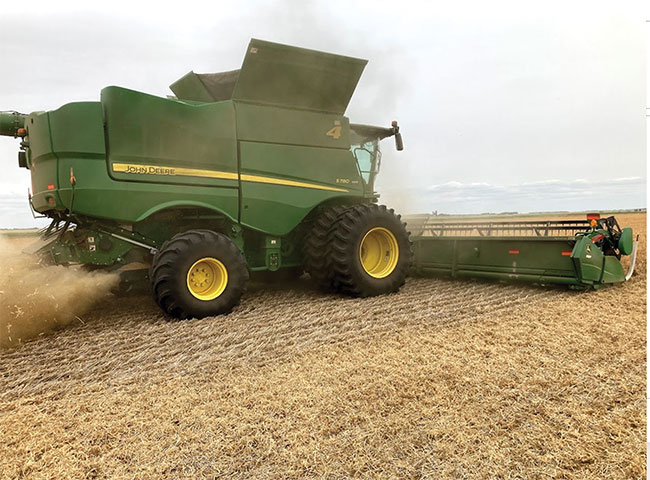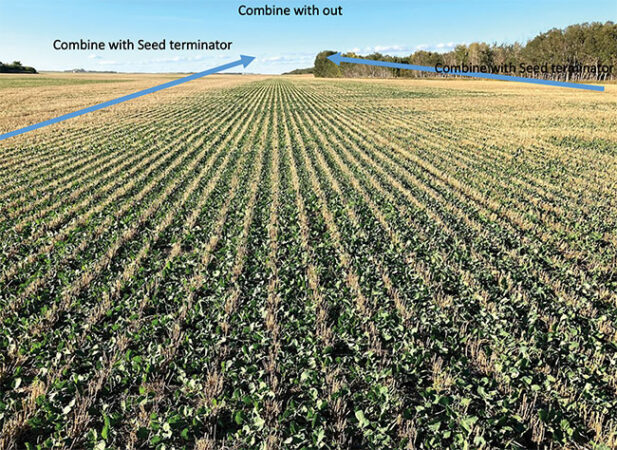
Features
Weeds
Putting numbers to harvest weed seed control
Five years of field experience with the Seed Terminator show benefits in weed control. And a payback.
May 10, 2023 By Bruce Barker
 Josh Lade is seeing a difference in weed pressure and herbicide costs after five years.
All photos courtesy of Josh Lade..
Josh Lade is seeing a difference in weed pressure and herbicide costs after five years.
All photos courtesy of Josh Lade.. Harvest weed seed control (HWSC) was born in Australia to help combat herbicide resistant weeds. There, many farmers are adopting different HWSC tools, including windrow burning, chaff lining, chaff collecting, baling, and combine impact mills that crush weed seeds in the chaff. In Canada, the greatest interest has been on impact mills such as the iHSD (Harrington Seed Destructor), Seed Terminator, Weed Hog and Redekop’s Seed Control Unit (SCU). Research has shown that these impact mills, mounted on the back of the combine, collect chaff and destroy over 90 per cent of weed seeds going through the mill.
“We did a lot of background work to look at how well an impact mill worked. On certain species, it worked really well,” says research scientist Breanne Tidemann at Agriculture and Agri-Food Canada at Lacombe, Alta.
Tidemann’s research used the original Harrington Seed Destructor (HSD) that was pulled behind a combine. The Australian manufacturer has since developed an integrated unit that is mounted in the combine. She has conducted several studies looking at the effectiveness of the impact mills, and what weed species are most suited for destruction by the mills.
After proof-of-concept was completed, Tidemann took the HSD to the field working with 20 farmer co-operators from 2017 through 2019. Three replicates were conducted on each field that compared a combine with and without the HSD. Weed seedling counts were conducted prior to seeding each spring, and in the final year, soil samples were taken to compare the weed seedbanks.
“We haven’t seen any significant differences in the data analysis. There haven’t been any major trends,” says Tidemann. “All I can say is that I’m surprised because I should have found some differences.”
Tidemann attributes the disappointing results to a few possibilities. The first was that a reduction in spring weed populations and the weed seedbank may not have shown up in such a short period of time of three years. “We knew that going in, but this was very expensive work to do and so we could only budget for three years.”
The second explanation relates to the nature of weeds themselves. Because weed populations are so variable across a field, the research focussed on areas of the field with heavy weed patches. But this would also be where the weed seedbank was the largest, so changes in weed seedling counts might not be measurable over three years.
“We knew this could be an issue when we started the project, but I don’t see how we could have changed that approach,” says Tidemann.
The third issue could be related to combine settings. To optimize the amount of weeds going into the chaff, the grain sample would also be dirty with weed seeds. “I wanted happy farmer co-operators, so my message to the technicians working with the farmers was to make sure the grain sample is clean so we could keep coming back for three years.”

In some years, the difference in spring weed pressure has been obvious.
Seeing a difference after 5 years
Over at Osler, Sask., Josh Lade has used the Australian-built Seed Terminator since 2018 when he had the impact mill mounted on one combine. In 2019, two of four combines had a Seed Terminator installed, three in 2020 and all four combines in 2021 and 2022. Lade is the Canadian distributor for Seed Terminator, and farms 16,000 acres in partnership with the Wiebe family.
“The critical pinch point in controlling weeds is harvest timing. The reality of weed control is that the weeds that survive to harvest are the fittest weeds that you will have a hard time controlling when their seeds germinate in the coming years,” says Lade.
Lade says that in addition to controlling over 90 per cent of weed seeds that go through the mill, that it can help to stop the spread of weed seeds during harvest. He says research has demonstrated that a combine is very efficient at spreading weeds. “Every farmer has seen this. When you hit a weed patch, the return goes through the roof, and it takes about 200 metres before it goes back down, so you’re spreading weeds down the field.”
Keeping weeds contained in patches is one of the benefits of using impact mills. Lade says that they are eliminating fence-to-fence spraying of wild oats because the weed is now contained in patches. They can map out where wild oat patches are, and only spot spray or spot treat patches with Avadex, saving significant herbicide and application costs. He has also found that herbicides can be hard on the crop, and has seen yield penalties from herbicide applications.
“The Seed Terminator gives us confidence to only spray patches of wild oats, so it does allow us to reduce herbicide costs,” says Lade.
He also says that they don’t do many two pass spray applications in herbicide tolerant canola any more. This reduction in herbicide costs, along with spot spraying wild oats is saving them five to 10 dollars per acre.
In the first few years, Lade could see a line in the field in the spring where combines with and without the Seed Terminator had harvested the previous fall. Areas with the Seed Terminator had visibly few weed seedlings.
“It’s not a silver bullet that will eliminate herbicide applications, but it will help reduce selection pressure for herbicide resistance,” says Lade. “After five years, we were seeing a reduction in the weed seedbank.”
The cost of a Seed Terminator is around $110,000. All the mills draw around 70 hp and are suited to Class 7 and higher combines. In Lade’s case, they are putting 4,000 acres of crop through each combine. Taking into consideration purchase price, additional fuel, and maintenance, he figures the cost of running the Seed Terminator is $6.16 per acre if used on 4,000 acres. That rises to $6.54 for 3,500 acres, and $6.86 on 3,000 acres per combine.
“To me, that’s the cost of one glyphosate application, and a lot less than a wild oat herbicide application,” he says. “The upfront sticker shock can look intimidating, but when you pencil it out over four years, the cost isn’t ridiculous.”
In Tidemann’s case, she is continuing to work with data analysis to see if she can come up with a significant difference in her research. “Some years I thought I could see a visual difference, but there is too much variation in the results with not enough differences to come out in the analysis that I have done to date.”
Tidemann adds that while her research isn’t showing differences, all of the proof of concept research suggests that the type of results Lade is seeing is more indicative of efficacy than the lack of significance in her results. Even without statistically significant results, Tidemann wouldn’t hesitate to suggest impact mills to farmers as a strategy to consider using for weed management on their farms.